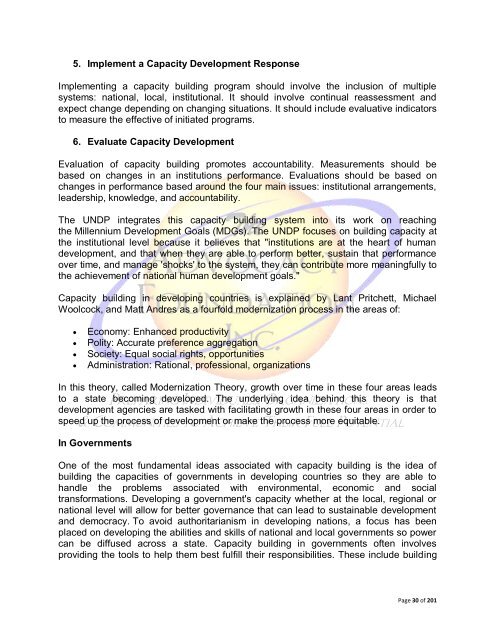ComeUnity CAPACITY BUILDING
ComeUnity CAPACITY BUILDING
ComeUnity CAPACITY BUILDING
Create successful ePaper yourself
Turn your PDF publications into a flip-book with our unique Google optimized e-Paper software.
5. Implement a Capacity Development Response<br />
Implementing a capacity building program should involve the inclusion of multiple<br />
systems: national, local, institutional. It should involve continual reassessment and<br />
expect change depending on changing situations. It should include evaluative indicators<br />
to measure the effective of initiated programs.<br />
6. Evaluate Capacity Development<br />
Evaluation of capacity building promotes accountability. Measurements should be<br />
based on changes in an institutions performance. Evaluations should be based on<br />
changes in performance based around the four main issues: institutional arrangements,<br />
leadership, knowledge, and accountability.<br />
The UNDP integrates this capacity building system into its work on reaching<br />
the Millennium Development Goals (MDGs). The UNDP focuses on building capacity at<br />
the institutional level because it believes that "institutions are at the heart of human<br />
development, and that when they are able to perform better, sustain that performance<br />
over time, and manage 'shocks' to the system, they can contribute more meaningfully to<br />
the achievement of national human development goals."<br />
Capacity building in developing countries is explained by Lant Pritchett, Michael<br />
Woolcock, and Matt Andres as a fourfold modernization process in the areas of:<br />
<br />
<br />
<br />
<br />
Economy: Enhanced productivity<br />
Polity: Accurate preference aggregation<br />
Society: Equal social rights, opportunities<br />
Administration: Rational, professional, organizations<br />
In this theory, called Modernization Theory, growth over time in these four areas leads<br />
to a state becoming developed. The underlying idea behind this theory is that<br />
development agencies are tasked with facilitating growth in these four areas in order to<br />
speed up the process of development or make the process more equitable.<br />
In Governments<br />
One of the most fundamental ideas associated with capacity building is the idea of<br />
building the capacities of governments in developing countries so they are able to<br />
handle the problems associated with environmental, economic and social<br />
transformations. Developing a government's capacity whether at the local, regional or<br />
national level will allow for better governance that can lead to sustainable development<br />
and democracy. To avoid authoritarianism in developing nations, a focus has been<br />
placed on developing the abilities and skills of national and local governments so power<br />
can be diffused across a state. Capacity building in governments often involves<br />
providing the tools to help them best fulfill their responsibilities. These include building<br />
Page 30 of 201

















